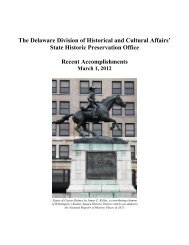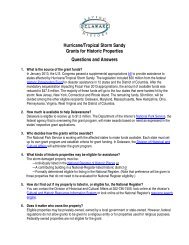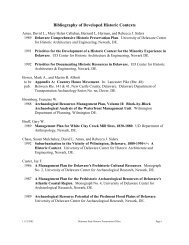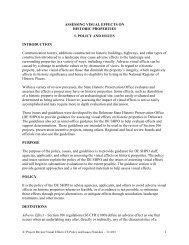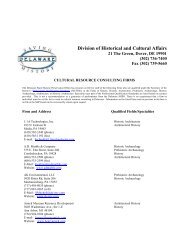Report of the Archaeological Investigations of the New Castle Court ...
Report of the Archaeological Investigations of the New Castle Court ...
Report of the Archaeological Investigations of the New Castle Court ...
You also want an ePaper? Increase the reach of your titles
YUMPU automatically turns print PDFs into web optimized ePapers that Google loves.
4.3.1 FEATURE 23 CERAMICS<br />
NEW CASTLE COURT HOUSE PLAZA<br />
NEW CASTLE, DELAWARE<br />
4.0 ARTIFACT ANALYSIS<br />
The analysis <strong>of</strong> <strong>the</strong> Feature 23 ceramics identified a minimum <strong>of</strong> 14 vessels. Due to <strong>the</strong><br />
fragmentary nature <strong>of</strong> <strong>the</strong> artifact assemblage, most <strong>of</strong> <strong>the</strong> vessels are based on only a single<br />
ceramic sherd. Vessel 1 represents a North Devon gravel-tempered utilitarian ware (Pope<br />
1986:99-103; Faulkner and Faulkner 1987:203-204) such as a kitchen hollowware; vessel<br />
identification was based on a body sherd from context 18. Vessel 2 was identified by a small<br />
diameter base sherd (from context 18) and may represent a Midlands Yellow drinking vessel or<br />
jug (Greaves 1976). An approximate 2.5 in. diameter base was calculated. A third vessel is<br />
represented by a buff-bodied ear<strong>the</strong>nware body sherd recovered from context 18. This sherd<br />
contained a manganese mottled glaze on both <strong>the</strong> interior and exterior sides. Vessel form and<br />
function are indeterminate. Vessel 4 corresponds to a coarse redware hollowware base sherd<br />
(context 18) with a manganese mottled interior glaze. Overall vessel form is unclear, but <strong>the</strong><br />
footed base suggests a possible beverage or a lesser tableware, ra<strong>the</strong>r than that <strong>of</strong> kitchen<br />
preparation. Vessel 5 denotes a redware vessel with a clear ginger-colored exterior glaze. This<br />
hollowware vessel was identified by two body sherds from context 18 (<strong>the</strong>se appear identical to<br />
Vessel 1 in <strong>the</strong> following Feature 37 discussion). The sixth vessel represents a refined, black<br />
glazed, redware tentatively identified as Wrotham (Grigsby 1993:22-27). Vessel identification<br />
was made from nine base and body sherds recovered from contexts 18 and 19. A slip trailed and<br />
dot decoration adorns <strong>the</strong> exterior and a base diameter <strong>of</strong> 3 in. was measured. Likely vessel forms<br />
include a small pitcher, mug, or posset pot. Vessel 7 denotes a possible refined black-glazed<br />
redware vessel identified by a handle base fragment (context 18). Little can be said about <strong>the</strong><br />
form or function <strong>of</strong> this vessel, except that is represents an indeterminate hollowware. A<br />
Staffordshire vessel with a slip-combed exterior, lead-glazed interior body sherd from context 19<br />
designates Vessel 8. This sherd likely indicates a hollowware, although overall form or function<br />
remains unknown (Grigsby 1993:38-63).<br />
Vessel 9 is represented by a tin-glazed ear<strong>the</strong>nware body sherd (context 18) with a blue handpainted<br />
exterior decoration on top <strong>of</strong> a white background. The body sherd is ra<strong>the</strong>r thin<br />
suggesting a non-utilitarian hollowware form, such as a tea or tableware. A second tin-glazed<br />
vessel was also present within <strong>the</strong> Feature 23 assemblage (Vessel 10). This vessel, represented by<br />
a plain, pink-tinted body sherd (context 18), is <strong>of</strong> unknown vessel form. Three <strong>of</strong> <strong>the</strong> remaining<br />
four vessels were derived from small Westerwald stoneware fragments recovered from context<br />
19. Few definitive comments can be made, except that each fragment appears to represent a<br />
unique hollowware vessel with exterior decorations ranging from incised/blue painted (Vessel<br />
11), molded/blue painted (Vessel 12), to finely molded/blue and purple painted (Vessel 13). It is<br />
possible that Vessels 11 or 12 could relate to <strong>the</strong> Westerwald drinking mug identified in Feature<br />
20 assemblage (discussed above). The final vessel (14) is a blue hand painted Chinese export<br />
porcelain body sherd recovered from context 19 likely representing a flatware vessel <strong>of</strong><br />
indeterminate size.<br />
4.3.2 FEATURE 37 CERAMICS<br />
A total <strong>of</strong> four ceramic vessels were identified during <strong>the</strong> ceramic analysis <strong>of</strong> Feature 37, a north<br />
to south orientated erosional feature extending southward from Feature 20. Vessel 1, represented<br />
by a single redware body sherd (context 154), is similar to Vessel 5 within <strong>the</strong> Feature 37 ceramic<br />
discussion. Little can be said about this hollowware fragment, save that its exterior has a clear<br />
ginger-colored glaze exterior treatment. Vessel 2, denoted by a single plain pearlware body<br />
(recovered from context 63), likely represents an indeterminate hollowware vessel. The third<br />
vessel designates an undecorated white salt-glazed stoneware hollowware body fragment<br />
recovered from context 154. The final vessel relates to a single fragment <strong>of</strong> Chinese export<br />
67





